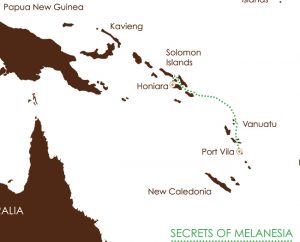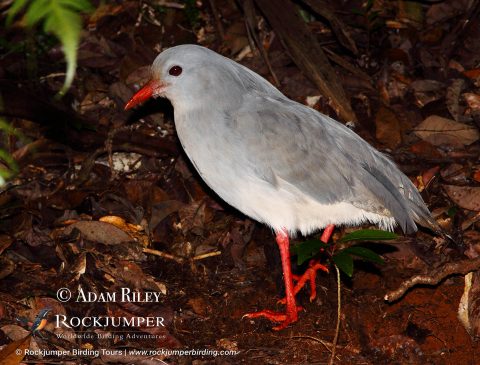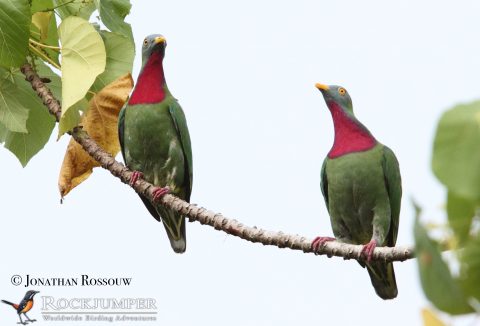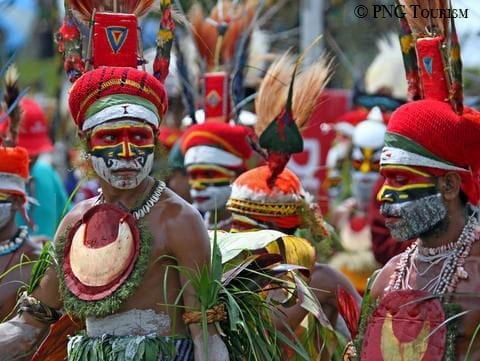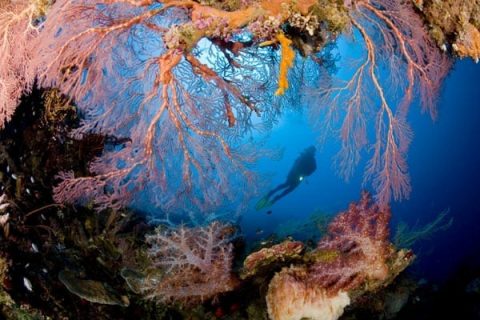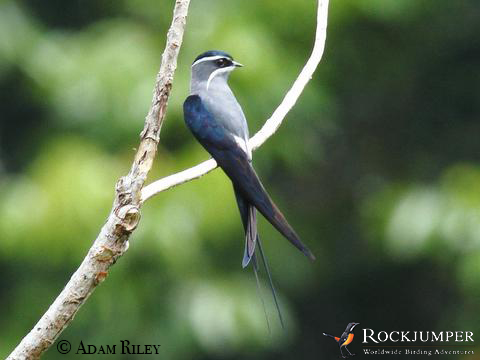Ask most folks where Melanesia is and more likely than not you’re met with a blank stare. To some it sounds more like a health condition best avoided, more so than a place name. Indeed, even of the “-esia” regions it is not the best known, overshadowed by Polynesia and/or the tiny shards and specks of land scattered across the western tropical Pacific that constitute the Federated States of Micronesia. Even people who don’t know where Polynesia and Micronesia are, have at least heard of them. Perhaps only Macaronesia, in the eastern tropical Atlantic, home to the Canary and Cape Verde islands, is less well known than Melanesia. And this is precisely part of its appeal.
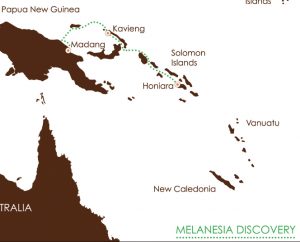
Route of the Melanesia Discoverer cruise, 8-21 October 2017, from Papua New Guinea, through the Bismarcks into the Solomons.
Route of the Secrets of Melanesia cruise, 20-31 October 2017, from the Solomons on through Vanuatu. Plus a New Caledonia extension!
How can a place be both famous and unknown? Seems impossible, yet that is the nebulous territory in our gray matter where Melanesia has taken up residence. Also known as “The Black Islands” (for reasons no one quite seems to agree upon), in fact there are over 2000 Islands in the region, several of which gained fame as battlegrounds in the Pacific theatre of World War II. Others remain hardly ever visited by westerners. Military occupation and battles along the Coral Sea at places like Guadalcanal enshrined this region in history, yet there are places like Tetepare, the South Pacific’s largest uninhabited island, and the Duff and Santa Cruz islands that have still seen few visitors. This is an archipelago of coral atolls, volcanoes, and idyllic tropical waters. Anchored north of Australia, the region includes (north to south) Papua New Guinea, the Bismarcks, the Solomon Islands, Vanuatu, New Caledonia, and Fiji. And it is a place of staggering biodiversity.
The Kagu, an odd endemic of New Caledonia, is the only species in its family, and thus a target on the New Caledonia extension.
Because this is one of the world’s most avian, endemic-rich hotspots on the planet, most diehard birders know it is a must-visit. The 200 or so endemic birds represent a big chunk of the world’s avifuana that cannot be seen anywhere else, but the problem has always been, how do you do it? How do you survey a bunch of little islands in the remote tropical Pacific? Until the arrival of these two new back-to-back Melanesian cruises, Melanesia Discoverer and Secrets of Melanesia, the best one could do was hope to puddle-jump a little here and there. Now, however, through these itineraries, the whole of Melanesia is within reach, and so many birds that forever lurked only as phantoms in the pages of our field guides can now be seen, heard, photographed and remembered. And discoveries may await.
One thing we do know, is that if you like doves and pigeons, this is ripe territory for you. Some of the world’s most spectacular and range-restricted doves are found here, including Nicobar Pigeon, Claret-breasted and Yellow-bibbed Fruit Doves, and Collared, Pinon’s, Zoe’s and Torresian Imperial Pigeon, to name a few. And other groups proliferate as well, with nearly every island sporting its own white-eye, myzomela or monarch. Of course there are the standout stars too to search for, such as Superb Pitta, Vanuatu Megapode, Sanford’s Sea Eagle, Mussau Triller, Palm Cockatoo, Blue-eyed Cockatoo, Cardinal Lory, Steel-Blue Flycatcher, and New Caledonia is famous as the only place in the world to see the odd, unusual, and monotypic Kagu.
The birds are just the beginning. This is one of the most culturally diverse places on the planet, with over 1300 languages known. Thirteen hundred! That’s one fifth of the total languages on the planet. Think about that. That is just over 700 square km/langauge, which is is by far the highest density of languages in the world. Today Melanesia is comprised of independent nations, or countries administered by France, and Christianity is the dominant religion. As noted, this is an area rich in history, and not just from the military action during the World Wars, but also as a place that gave rise to the Lapita people who, dating back to 1600BC, appear to be the first humans to have achieved real expertise in seamanship and sea navigation. And it was they who eventually went on to colonize the remotest islands, such as Hawaii and Easter Island.
Melanesia includes Papua New Guinea, the Bismarcks, the Solomon Islands, Vanuatu, New Caledonia, and Fiji, and is one of the most culturally rich regions on the planet.
And yet for the most part, what’s in Melanesia stays in Melanesia. This is true of both the birds and the people. That is how you end up with hundreds of languages evolving in close proximity to one another, and dozens of endemic bird species. There is very little traffic in or out, which is part of why so few have been still, and this produces a genuine uniqueness. An examination of the avifuana shows that very few bird species migrate in, out or through the islands. Nearly everything there just stays there, and that is true whether you are a Bougainville Bush Warbler (described just in 2006), or a Solomon Islander. Mostly you stay put. And heck, why wouldn’t you? There is nothing wrong with the weather and the waters are a beautiful blue all year long.
Rich with birds, rich in culture and history, and anchored amid the heart of the Coral Triangle, Melanesia harbors ¾ of the world’s coral species and about 3000 fish species associated with them. And beyond the coral blue waters the scenery ain’t too shabby either, and much of the coastline seems lifted straight out of the film “The Blue Lagoon”. In fact the filming of that movie on Fiji in 1980 inadvertently revealed to the world a species of Iguana utterly unknown to science. Such discoveries likely yet remain. We will search for dugongs, spinner dolphins, and flying foxes, during this cruise through placid Melanesia. The seas here are quite calm compared to more turbulent parts of the Pacific, and provide a bounty of fresh seafood. Between sightings of Vulturine Parrot, Blyth’s Hornbill, and Paradise Drongo, we may see some of the largest beetles in the world, and possibly the largest butterfly on the planet, all while surrounded by blue waters offering arguably the best snorkeling in the world. Join George Armistead for a Rockjumper adventure to an avian frontier and a cultural goldmine, and make it Melanesia in 2017.
With about 200 endemic species, Melanesia also hosts a number of smart-looking regional specialties, such as the Moustached Treeswift.
